World War II
Discuss WWII and the era directly before and after the war from 1935-1949.
Discuss WWII and the era directly before and after the war from 1935-1949.
Hosted by Rowan Baylis
Tamiya 1/48th P-47 issues vs Hasegawa
GastonMarty

Joined: April 19, 2008
KitMaker: 595 posts
AeroScale: 507 posts

Posted: Saturday, September 11, 2010 - 10:51 PM UTC
Hello everyone,
I posted these observations about the Tamiya 1/48th series of P-47s vs the Hasegawa Bubbletop kit on Britmodeller.com:
http://www.britmodeller.com/forums/index.php?showtopic=55476&start=0&p=591350&#entry591350
A long thread! I haven't quite got around to reading it yet...
I think the older Hasegawa Bubbletop kit might offer interesting kitbashing solutions for the Tamiya kit (given the current absence of real serious Falcon vacu-form clear parts). This Hasegawa kit however is getting harder to find now in some major on-line stores...
Gaston
P.S. I should mention the Hasegawa 1/48th Razorback has an inaccurate canopy cross-section, and is thus not considered in my post.
G.

Kriegshund

Joined: December 12, 2006
KitMaker: 132 posts
AeroScale: 108 posts

Posted: Wednesday, September 15, 2010 - 01:14 AM UTC
It appears the thread over there has been pulled......
GastonMarty

Joined: April 19, 2008
KitMaker: 595 posts
AeroScale: 507 posts

Posted: Wednesday, September 15, 2010 - 03:43 AM UTC
Yes, I will post some of the original post content here later...
Jeez...
Gaston
GastonMarty

Joined: April 19, 2008
KitMaker: 595 posts
AeroScale: 507 posts

Posted: Thursday, September 16, 2010 - 01:40 PM UTC
Here it goes...
I don't know what it is on some sites that you cannot criticize Tamiya kits at all without causing a scandal, or that photographic evidence is in no way considered acceptable for that particular maker (but is OK for other makers)...
In any case here is the gist of the content of the link to my previous post...
You often hear how the Tamiya 1/48th P-47 kit is one of the greatest kits ever offered in 1/48th scale. It does make quite an impression on opening the box... But for the general outline (which is my absolute priority when I build), it is not as good as many other kits of other WWII subjects in that scale (certainly not even in top 30-40 in my view), and may not even be the best starting point for a 1/48th P-47. (I would likely prefer correcting the Hasegawa's Bubbletop shallow fuselage/cowl myself, but that is still speculation on my part at this point)
To clarify things for the 1/48th Razorback version, the Hasegawa kit canopy has a very wrong canopy cross-section, and the Tamiya kit is here clearly superior, but the Tamiya windshield is also far too deep (or also short?) and not fixable, so only the Bubbletop versions are considered here. (The Tamiya Razorback's plan view of the fuselage shares the same intractable "swelling" problems as the Tamiya Bubbletop version)
Perhaps the Otaki or Monogram Razorbacks could be considered for kitbashing along those lines? (I particularly like the Otaki but haven't seen it in a long time)
These are the problems with the Tamiya Bubbletop:

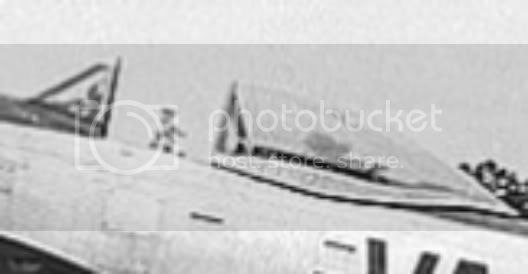
The problem appears to be one of excessive canopy depth. The slightly more slanted angle of the real aircraft windshield is confirmed by all other photos, and thus confirms that this photo is not "stretched" to give the sliding canopy portion its shallower appearance here.
Both canopies are in the same fully open position... (Gulp!)
Also the leading edge angle of the real fin matches the kit photo, as does the height of the wingtip relative to the fuselage, indicating a very close approximation in viewing angle, and thus a fair, if not exact, comparison:


The recent 1/32 scale Hasegawa canopy looks far more plausible, and may be similar in that respect to the Hasegawa 1/48th kit...:
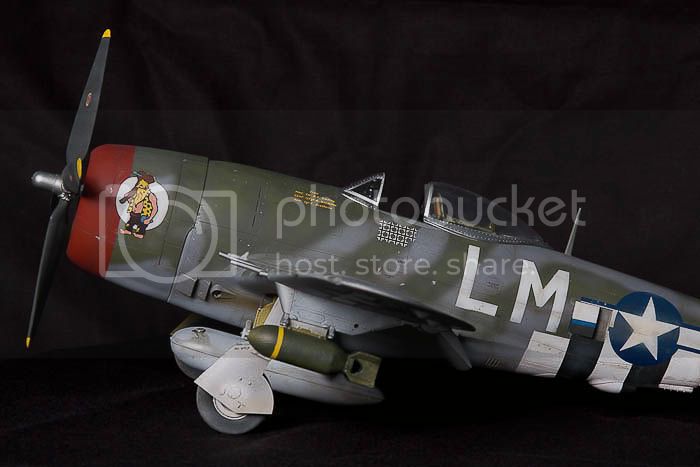
Another problem with the Tamiya canopy that the Hasegawa canopy also avoids is more difficult to see, and much harder to find in photos... This is the best I could find so far, but I know for having had the Tamiya kit, and looking at photos with the actual part in hand, that it is noticeable...:
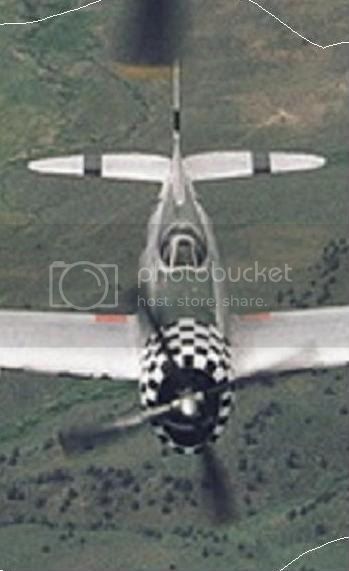
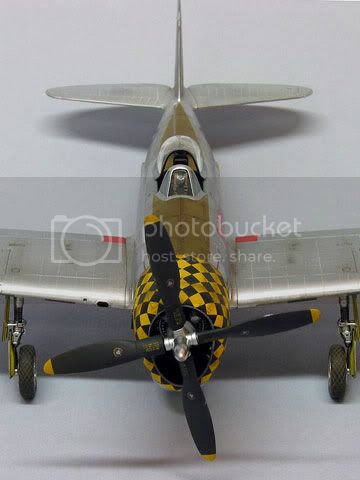
The extra bottom "splaying" of the kit part is visible here. Less obvious, but just as important, is the slanting angle of the side windows, which appear to "pinch" more around the narrower-looking real windshield.
Also visible here, if you carefully discount the confusing effect of the real aircraft's white/black checkered cowl, is the the "tapering" of the cowling on the Tamiya kit, aggravated further by the combined "swelling" of the kit fuselage to a 3 mm overscale width dimension at cockpit level.
No such "swelling-tapering" exists in real life, as agreed upon by all drawings I have seen, and at least one overhead photo of a P-47B that was very clear on this issue...:
http://www.mnbigbirds.com/images/3%20Views/P47/P-47N%201%20RE.jpg
This is how master modeler Yoyuso (who discovered this particular problem)went about to correct this:

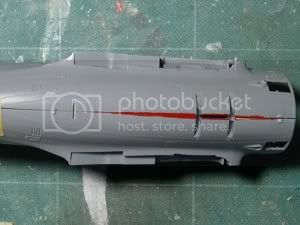

Note that the effect is not that huge on the cowling alone: It is when combined with the swelling of the fuselage that the full effect is visible. Given the rarity of direct overhead photos, I had not noticed this (I don't studiously trust drawings for any solid shape information). Now that I know this however, I agree with Yoyuso this is clearly unacceptable... This is especially true if we consider the usual point of view we have on our models...
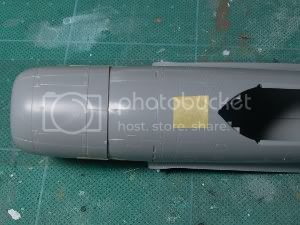
The Hasegawa 1/48th depicts this plan view correctly, and you can also see here the more correct, more narrowly splayed windshield as well:
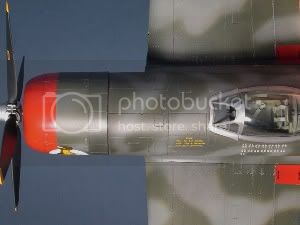
For these two reasons, the fuselage plan view and the canopy, I would certainly prefer correcting the shallow Hasegawa fuselage/cowl problem than deal with the very complex solution Yoyuso found for the plan view of the Tamiya kit... Maybe some sort of kit -bashing of the two kits, or with another kit, would solve the Hasegawa problems...
Re-scribing all the details of the Tamiya cowl strikes me as a very difficult task, but I learned long ago it is not easy to anticipate what is easy and what is not...
Yoyuso is an extraodinary modeler: his correction of the SB2C Helldiver and especially of the Ki-44 Tojo are real highlights, but he is without peer in many other ways... (His correction of the Hasegawa Me-109F is the only one I could find any real faults with, in the nose shape, tail depth and uncorrected fuselage width notably: The Hasegawa kit is a great challenge, and a redundant one since the Zvezda kit...)
The P-47N build article:
http://www.geocities.jp/yoyuso/p47n/p47ne.html
His site; http://www.geocities.jp/yoyuso/top2.htm
I will try to find a Hasegawa 1/48th Bubbletop kit, and will provide updates if I find a way to kitbash its profile depth problem in a way that is easier than Yoyuso's solution for the Tamiya kit's plan view problem...
Thanks for your interest.
Gaston
Posted: Sunday, September 19, 2010 - 09:57 AM UTC
This topic of conversation would probably be better suited for Aeroscale's sister site P-47 Heaven? 

GastonMarty

Joined: April 19, 2008
KitMaker: 595 posts
AeroScale: 507 posts

Posted: Sunday, September 19, 2010 - 01:52 PM UTC
Yes, I posted a link there

Gaston
GastonMarty

Joined: April 19, 2008
KitMaker: 595 posts
AeroScale: 507 posts

Posted: Tuesday, September 28, 2010 - 05:22 PM UTC
Concerning the use of photos to correct the outline of kits, an often controversial issue despite the clarity of the problems described here, I would add the following points:
-Thin wide-angle lenses from typical, cheap, WWII cameras have little distortion except near the photo's edges, so WWII pictures taken from square angles, AND also from some significant distance, are often an excellent reference for shape, especially when compared directly with the actual kit part to your one open eye...
-Modern close-up photos of kits, with thicker more advanced lenses, are more of a comparison problem than the above, but remember that this can be countered by using just the actual kit part and your Mk 1 eyeball for the kit side of the comparison...
-Near the center of the image, as with the P-47 canopies here, distortion effects are greatly reduced.
-Distortions from square viewing angles are similar on either side of the lense, so adjustments in viewing can still be made for real major errors. Ie: If one side doesn't match because of distortion, then the other should be similarly affected if the photo is taken from a square angle...
-Distortion problems almost always leave tell-tale warnings of what you are looking at...
-Dimensions can be compared and measured to a kit if the kit has at least one dimension correct: in the Vertical or the Horizontal. If BOTH the vertical and horizontal are wrong on the kit, then I agree all dimensional reference points are lost, and correcting such a kit is impossible without measuring the actual item... This is exactly the problem I encountered with with the Hasegawa 1/48th and 1/32 Me-109s, whose cross-section is too shallow 2" vertically and too wide 2" horizontally, for a combined effect of 4 inches, or visually something looking like near 20% of the actual fuselage width of around 24 inches...
Kits such as these, that are completely fictional in cross-section, both vertically AND horizontally, are fortunately quite rare...
-No drawing, including blueprints, represents curves correctly, so to get curves exactly right there is NO alternative to photographs...
This is not quite as big an issue for tanks and vehicles, but even for those, straight lines are not always placed reliably in relation to each other, since the slanting of plates and surfaces throws off the exact outline appearance...
-The real item is usually unavailable, and in contrast to often very courteous and helpful flying museums, static museums are typically extremely unhelpful, as I know from experience...
This is a series of profiles I made for my boardgame variant of the Avalon Hill Air Force system:
http://forums.ubi.com/eve/forums/a/tpc/f/4811054957/m/5031083708?r=5031083708#5031083708
The performance comparison was done over 14 years of research: All the profile drawings had to be corrected or entirely made using photos: An accurate rough outline existed nowhere...
I have yet to see a remotely correct DRAWING representation of the P-51B/C/D Mustang's belly radiator rear curve, yet both the Tamiya 1/48th kit and the Hasegawa 1/48th P-51D are quite adequate...
More often that not, a good recent WWII aircraft kit beats most, or all, drawings in outline accuracy, which makes using those drawings as a reference rather unhelpful...
I will only point to the masterful correction of a 1/48th Gavia La-7, a few years ago, that was widely published, but that used a drawing to "correct", with great effort, the kit's rear canopy, which was already correct...
(My above linked profile drawing of a Me-163B does exhibits a slight shortness in the fin/rudder chord, for the sole reason I used a photo that was not quite from a perfectly square angle viewpoint... A better, squarer photo was found only later, and would have made a better reference...)
The problem with almost all WWII aircraft drawings is that the relationship between the vertical and the horizontal is not respected, in addition to the complexity of representing the various curves correctly, and that has resulted in all 1/48th Me-163Bs models, for example, being similarly too shallow, including the Finemolds 1/48th J8M Japanese copy!
Leaving models uncorrected in shape is fine, but the moment you want to correct the shape outline, I simply see no alternative to consulting photos, however numerous the pitfalls... These pitfalls are nothing compared to what drawings, or trying to measure curved surfaces, offer...
Gaston
GastonMarty

Joined: April 19, 2008
KitMaker: 595 posts
AeroScale: 507 posts

Posted: Friday, October 29, 2010 - 09:59 AM UTC
I have had the opportunity now to examine all the best available P-47 kits in 1/48th scale, save for the raised panel lines Monogram.
New observations partially ammend what I said above about the Tamiya fuselage, since that observation was not my own but that of Master Modeler Yoyuso. (The canopy observations I had made years ago with the actual kits in hand)
The cowl plan view is indeed tapered very slightly, which is wrong. However, in considering the Tamiya fuselage, I did not find it to be "swollen" to match the taper, but simply overall wider by virtue of the cowl tapering outward at the rear by about an extra .75 mm per side, totally 1.5 to 2 mm of extra width in plan view. I do know, from a very early review of this kit, that its fuselage width is dimensionally overscale by about this amount...
I would say a minor amount of paralel trimming of the fuselage halves totalling 1 mm would be enough to be in the ballpark, without the complexity of taking out whatever mid-lenght swelling there is, if there is any...
The Tamiya cowl does need to be de-tapered, but instead of the very complex method Yoyuso outlined, with all the attendant re-scribing, I would suggest simply adapting to the Tamiya fuselage the Otaki cowl which is not tapered and is also slightly more accurate in appearance.
There is good news in alternative kits: The Otaki P-47D Razorback is in my opinion the best kit Otaki has done, and is generally superior in outline to the Tamiya Razorback kit, while having the same profile but a slightly better canopy that can be improved further, unlike the Tamiya canopy... I will post a build of this very good kit to illustrate this.
Bad news is the Hasegawa P-47D Bubbletop kit, which despite a correct plan view is so poor in profile depth that it is completely unuseable in every respect. The canopy glass is more accurate but the sliding frame portion of the "bubble" is very poor and will have to be adapted from the Tamiya kit, which I think is possible.
Therefore, for the Bubbletop Tamiya kit, a slightly narrowed Tamiya fuselage will be used with an Otaki cowl and a Hasegawa canopy with a Tamiya sliding frame adapted to its "bubble" portion.
To fit the Hasegawa windshield to the Tamiya fuselage, a portion of the Hasegawa fuselage under the windshield will have to be somehow grafted...
The Razorback is actually slightly harder to fix fully, but the Otaki kit looks very satisfying to my eyes even out of the box. I will make mine into a "Doublebolt" using a specific combination of Tamiya and Otaki clear parts, which solves some of the bottom canopy frame over-thickness on the Otaki kit...
It will be awhile, but the two kits are very high on my "to-do" list now...
Gaston
Posted: Friday, October 29, 2010 - 10:37 AM UTC
Have you noticed Gaston that no one really cares what you think??
 |















